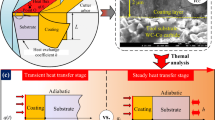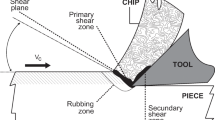Abstract
Interrupted cutting operations, such as milling, produce fluctuating tool temperatures which directly affect the process outputs. Thus, prediction of cutting tool temperatures enables process planning, selection of materials for tool substrate and coating layers, and tool geometric design for improved productivity in machining operations. Theoretical analysis of temperature is a cost effective way to predict the tool temperatures. Considering the industrial needs, a theoretical model should be fast, easy to implement, and reliable. To that end, a novel hybrid model, which assembles analytical and numerical methods, is proposed in this study. This novel transient thermal model simulates the interrupted cutting with coated cutting tools. The proposed model includes an analytical heat flux calculation at the tool-chip interface considering the sticking-sliding contact behavior. The determined heat flux is, then, used to perform a numerical solution of the transient heat conduction problem in the cutting tool geometry with temperature-dependent thermal properties. The developed model is validated with experimental results found in literature under different cutting conditions. The results show that the model can predict the maximum temperatures generated in a thermal cycle with an accuracy of 2–10%. Thus, the proposed model can be further used to determine the process parameters, properties of coating layers, and tool geometric design.


















Similar content being viewed by others
Abbreviations
- A,B,C,n,ν:
-
Johnson-Cook material constants
- γ :
-
Shear strain
- \( \dot{\gamma} \) :
-
Shear strain rate (1/s)
- \( {\dot{\gamma}}_0 \) :
-
Reference shear strain rate (1/s)
- γ 1 :
-
Shear strain at the exit of the band
- ϕ :
-
Shear angle
- l c :
-
Total contact length (m)
- l p :
-
Sticking length (m)
- μ :
-
Sliding friction coefficient
- P(x) :
-
Pressure distribution on rake face (Pa)
- q "(x):
-
Heat flux into the tool (W/m2)
- F t :
-
Tangential cutting force (N)
- P t :
-
Cutting power (W)
- b :
-
Width of cut (m)
- ω :
-
Constant velocity distribution ratio
- R t :
-
Cutting tool radius (m)
- t :
-
Time (s)
- t 1 :
-
Heating/cutting time (s)
- t 2 :
-
Cooling/non-cutting time (s)
- n :
-
Integer number
- k, k 1 , k 2 :
-
Thermal conductivity (W/mK)
- T :
-
Absolute temperature (K)
- T r :
-
Reference temperature (K)
- T m :
-
Melting temperature (K)
- τ s :
-
Shear stress (Pa)
- τ 0 :
-
Shear stress at the entry of the shear band (Pa)
- τ 1 :
-
Shear stress at the exit of the shear band (Pa)
- ρ :
-
Material density (kg/m3)
- V :
-
Cutting speed (m/s)
- V c :
-
Chip velocity (m/s)
- V c0 :
-
Chip velocity constant (m/s)
- V N :
-
Normal velocity component (m/s)
- h 1 :
-
Uncut chip thickness (m)
- T w :
-
Absolute temperature of workpiece (K)
- β :
-
Taylor-Quinney coefficient
- c :
-
Heat capacity of workpiece (J/kgK)
- α :
-
Rake angle
- λ a :
-
Apparent friction angle
- ζ :
-
Stress distribution exponent
- P 0 :
-
Normal pressure constant (N/m2)
- μ a :
-
Apparent friction coefficient
- a e :
-
Radial immersion/radial depth of cut (m)
References
Trigger K, Chao B (1951) An analytical evaluation of metal cutting temperature. Trans ASME 73:57–68
Komanduri R, Hou ZB (2000) Thermal modeling of the metal cutting process part I: temperature rise distribution due to shear plane heat source. Int J Mech Sci 42(9):1715–1752
Komanduri R, Hou ZB (2001) Thermal modeling of the metal cutting process part II: temperature rise distribution due to frictional heat source at the tool–chip interface. Int J Mech Sci 43(1):57–88
Komanduri R, Hou ZB (2001) Thermal modeling of the metal cutting process—part III: temperature rise distribution due to the combined effects of shear plane heat source and the tool–chip interface frictional heat source. Int J Mech Sci 43(1):89–107
Stephenson DA, Ali A (1992) Tool temperatures in interrupted metal cutting. J Eng Ind 114(2):127–136
Sato M, Tamura N, Tanaka H (2011) Temperature variation in the cutting tool in end milling. ASME J Manuf Sci Eng 133(2):021005–021005
Karaguzel U, Budak E (2018) Investigating effects of milling conditions on cutting temperatures through analytical and experimental methods. J Mater Process Technol 262:532–540
Ozlu E, Budak E, Molinari A (2009) Analytical and experimental investigation of rake contact and friction behavior in metal cutting. Int J Mach Tools Manuf 49(11):865–875
Su JC, Young KA, Ma K, Srivatsa S, Morehouse JB, Liang SY (2013) Modeling of residual stresses in milling. Int J Adv Manuf Technol 65(5-8):717–733
Teppernegg T, Klünsner T, Angerer P, Tritremmel C, Czettl C, Keckes J, Ebner R, Pippan R (2014) Evolution of residual stress and damage in coated hard metal milling inserts over the complete tool life. Int J Refract Met Hard Mater 47:80–85
Nemetz AW, Daves W, Klünsner T, Ecker W, Schäfer J, Czettl C, Antretter T (2019) Cyclic heat-up and damage-relevant substrate plastification of single-and bilayer coated milling inserts evaluated numerically. Surf Coat Technol 360:39–49
Nemetz W, Daves W, Klünsner T, Ecker W, Teppernegg T, Czettl C, Krajinović I (2018) FE temperature-and residual stress prediction in milling inserts and correlation with experimentally observed damage mechanisms. J Mater Process Technol 256:98–108
Nemetz AW, Daves W, Klünsner T, Praetzas C, Liu W, Teppernegg T, Czettl C, Haas F, Bölling C, Schäfer J (2020) Experimentally validated calculation of the cutting edge temperature during dry milling of Ti6Al4V. J Mater Process Technol 278:116544
Ozel T, Altan T (2000) Process simulation using finite element method—prediction of cutting forces, tool stresses and temperatures in high-speed flat end milling. Int J Mach Tools Manuf 40(5):713–738
Thepsonthi T, Ozel T (2013) Experimental and finite element simulation based investigations on micro-milling Ti-6Al-4V titanium alloy: effects of cBN coating on tool wear. J Mater Process Technol 213(4):532–542
Grzesik W, Bartoszuk M, Nieslony P (2005) Finite element modelling of temperature distribution in the cutting zone in turning processes with differently coated tools. J Mater Process Technol 164:1204–1211
Brito RF, De Carvalho SR, Ferreira JR (2009) Thermal analysis in coated cutting tools. Int Commun Heat Mass 36(4):314–321
Lazoglu I, Altintas Y (2002) Prediction of tool and chip temperature in continuous and interrupted machining. Int J Mach Tools Manuf 42(9):1011–1022
Ulutan D, Lazoglu I, Dinc C (2009) Three-dimensional temperature predictions in machining processes using finite difference method. J Mater Process Technol 209(2):1111–1121
Islam C, Lazoglu I, Altintas Y (2016) A three-dimensional transient thermal model for machining. J Manuf Sci Eng 138(2)
Islam C, Altintas Y (2019) A two-dimensional transient thermal model for coated cutting tools. J Manuf Sci Eng 141(7):071003
Melkote SN, Grzesik W, Outeiro J, Rech J, Schulze V, Attia H, Arrazola PJ, Saoubi RM, Saldana C (2017) Advances in material and friction data for modelling of metal machining. CIRP Ann-Manuf Techn 66(2):731–754
Zorev NN (1963) Inter-relationship between shear processes occurring along tool face and shear plane in metal cutting. Int Research Production Eng 49:143–152
Behera BC, Ghosh S, Rao PV (2018) Modeling of cutting force in MQL machining environment considering chip tool contact friction. Tribol Int 117:283–295
SNB O, Karpat Y (2017) Investigating the influence of friction conditions on finite element simulation of microscale machining with the presence of built-up edge. Int J Adv Manuf Technol 90(1-4):819–829
Peng B, Bergs T, Schraknepper D, Smigielski T, Klocke F (2020) Development and validation of a new friction model for cutting processes. Int J Adv Manuf Technol:1–13
Molinari A, Dudzinski D (1992) Stationary shear bands in high speed machining. C R Acad Sci 315(Série II):399–405
Ozlu E, Molinari A, Budak E (2010) Two-zone analytical contact model applied to orthogonal cutting. Mach Sci Technol 14(3):323–343
Dudzinski D, Molinari A (1997) A modelling of cutting for viscoplastic materials. Int J Mech Sci 39(4):369–389
Moufki A, Molinari A, Dudzinski D (1998) Modelling of orthogonal cutting with a temperature dependent friction law. J Mech Phys Solids 46(10):2103–2138
Merchant ME (1945) Mechanics of the metal cutting process. II. Plasticity conditions in orthogonal cutting. J. Appl Phys 16:318–324
Li L, Li B, Ehmann KF, Li X (2013) A thermo-mechanical model of dry orthogonal cutting and its experimental validation through embedded micro-scale thin film thermocouple arrays in PCBN tooling. Int J Mach Tools Manuf 70:70–87
Altintas Y (2000) Manufacturing automation. The Press Syndicate of the University of Cambridge, Cambridge
MATLAB (2019) Partial Differential Equation Toolbox™ user’s guide
Armendia M, Garay A, Villar A, Davies MA, Arrazola PJ (2010) High bandwidth temperature measurement in interrupted cutting of difficult to machine materials. CIRP Ann-Manuf Techn 59(1):97–100
Sölter J, Gulpak M (2012) Heat partitioning in dry milling of steel. CIRP Ann-Manuf Techn 61(1):87–90
Li L, He N (2006) A FEA study on mechanisms of saw-tooth chip deformation in high speed cutting of Ti–6–Al–4V alloy. In: Fifth International Conference on High Speed Machining (HSM). Metz, France, pp 759–767
Ozel T, Sima M, Srivastava AK, Kaftanoglu B (2010) Investigations on the effects of multi-layered coated inserts in machining Ti–6Al–4V alloy with experiments and finite element simulations. CIRP Ann-Manuf Techn 59(1):77–82
Akbar F, Mativenga P, Sheikh M (2008) An evaluation of heat partition in the high-speed turning of AISI/SAE 4140 steel with uncoated and TiN-coated tools. Proc Inst Mech Eng Part B: J Eng Manuf 222(7):759–771
Abukhshim N, Mativenga P, Sheikh M (2005) Investigation of heat partition in high speed turning of high strength alloy steel. Int J Mach Tools Manuf 45(15):1687–1695
Praetzas C, Teppernegg T, Mayr J, Czettl C, Schäfer J, Abele E (2018) Investigation of tool core temperature and mechanical tool load in milling of Ti6Al4V. Procedia CIRP 77:118–121
Valiorgue F, Brosse A, Naisson P, Rech J, Hamdi H, Bergheau JM (2013) Emissivity calibration for temperatures measurement using thermography in the context of machining. Appl Therm Eng 58(1-2):321–326
Hutchings I, Shipway P (2017) Tribology: friction and wear of engineering materials. Butterworth-Heinemann
Zhao J, Liu Z (2018) Effects of thermo-physical properties of Ti0. 41Al0. 59N coating on transient and steady cutting temperature distributions in coated cemented carbide tools. Int Commun Heat Mass 96:80–89
Krajinović I, Daves W, Tkadletz M, Teppernegg T, Klünsner T, Schalk N, Mitterer C, Tritremmel C, Ecker W, Czettl C (2016) Finite element study of the influence of hard coatings on hard metal tool loading during milling. Surf Coat Technol 304:134–141
Opitz H, Lehewald W (1963) Untersuchungen über den Einsatz von Hartmetallen beim Fräsen. Forschungsberichte des Landes Nordrhein-Westfalen Nr. 1146. Köln und Opladen: Westdeutscher Verlag
Availability of data and materials
In order to reach the presented data in the paper, one can contact with the author.
Author information
Authors and Affiliations
Contributions
All the work has been performed by the author.
Corresponding author
Ethics declarations
Ethical approval
Not applicable
Consent to participate
The author hereby consents to participate.
Consent to publish
The author hereby consents to the publication of the proposed manuscript in JAMT.
Competing interests
The author declares no competing interests.
Additional information
Publisher’s note
Springer Nature remains neutral with regard to jurisdictional claims in published maps and institutional affiliations.
Rights and permissions
About this article
Cite this article
Karaguzel, U. Transient multi-domain thermal modeling of interrupted cutting with coated tools. Int J Adv Manuf Technol 116, 345–361 (2021). https://doi.org/10.1007/s00170-021-07388-6
Received:
Accepted:
Published:
Issue Date:
DOI: https://doi.org/10.1007/s00170-021-07388-6




